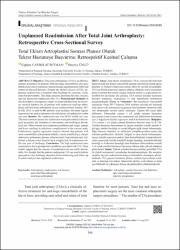| dc.contributor.author | Canbolat Seyman, Çiğdem | |
| dc.contributor.author | Ünlü, Hayriye | |
| dc.date.accessioned | 2023-05-26T07:20:01Z | |
| dc.date.available | 2023-05-26T07:20:01Z | |
| dc.date.issued | 2021 | en_US |
| dc.identifier.uri | https://search.trdizin.gov.tr/tr/yayin/detay/495860/unplanned-readmission-after-total-joint-arthroplasty-retrospective-cross-sectional-survey | |
| dc.identifier.uri | https://hdl.handle.net/20.500.12868/2177 | |
| dc.description.abstract | Objective: Total joint arthroplasty (TJA) is an effective surgical procedure for patients with end-stage osteoarthritis who have failed conservative treatments, demonstrating significant pain relief and improved physical function. Despite the clinical success of TJA, unplanned readmissions to hospitals after discharge are common, costly, and often preventable. This study aimed to determine the rates, reasons, and risk factors for readmission after TJA. Material and Methods: In this descriptive, retrospective study, we analyzed data from an electronic medical database for all patients who underwent total hip arthroplasty and total knee arthroplasty at one institution from January 2017 to July 2018. A total of 440 patients were included. Bivariate logistic regression was used to determine the risk factors of readmission within one year. Results: The readmission rate was 34.3% within one year. The most common reasons for readmission were pain related to the surgical procedure, the limitation of movements, and swelling at the surgical site. Other reasons were respiratory problems and cough, sputum and fever resulting in infectious complications in the current study. Furthermore, logistic regression analysis showed that patients with some comorbidities (rheumatoid arthritis, venous insufficiency, chronic obstructive pulmonary disease, atherosclerotic heart disease and, Alzheimer’s disease) were found to have a higher risk of readmission within one year of discharge. Conclusion: The high readmission rates commonly is due to postoperative problems associated with TJA. These results suggest that the reasons of readmission are not easily preventable. It is thought that the patients undergoing TJA can need a holistic approach to care, discharge education, home monitoring, and follow-up to reduce and prevent unplanned readmission. | en_US |
| dc.language.iso | eng | en_US |
| dc.relation.isversionof | 10.5336/medsci.2020-80269 | en_US |
| dc.rights | info:eu-repo/semantics/openAccess | en_US |
| dc.subject | Arthroplasty | en_US |
| dc.subject | Readmission | en_US |
| dc.subject | Risk Factors | en_US |
| dc.subject | Pain | en_US |
| dc.subject | Total Hip Arthroplasty | en_US |
| dc.subject | Total Knee Arthroplasty | en_US |
| dc.subject | Artroplasti | en_US |
| dc.subject | Yeniden Başvuru | en_US |
| dc.subject | Risk Faktörleri | en_US |
| dc.subject | Ağrı | en_US |
| dc.subject | Total Kalça Artroplastisi | en_US |
| dc.subject | Total Diz Artroplastisi | en_US |
| dc.title | Unplanned Readmission After Total Joint Arthroplasty: Retrospective Cross-Sectional Survey | en_US |
| dc.type | article | en_US |
| dc.contributor.department | ALKÜ, Fakülteler, Sağlık Bilimleri Fakültesi, Hemşirelik Bölümü | en_US |
| dc.identifier.volume | 41 | en_US |
| dc.identifier.issue | 4 | en_US |
| dc.identifier.startpage | 390 | en_US |
| dc.identifier.endpage | 397 | en_US |
| dc.relation.journal | Türkiye Klinikleri Tıp Bilimleri Dergisi | en_US |
| dc.relation.publicationcategory | Makale - Uluslararası Hakemli Dergi - Kurum Öğretim Elemanı | en_US |


















